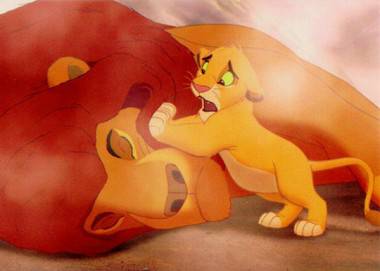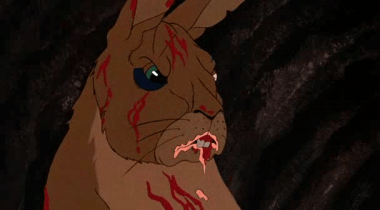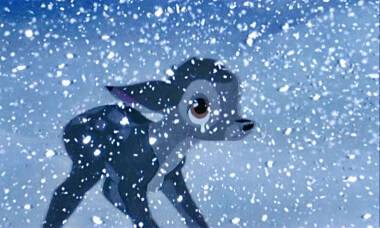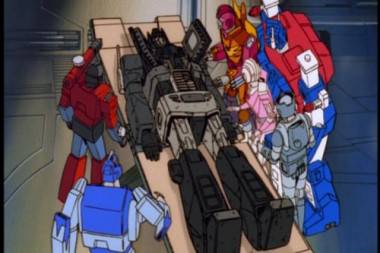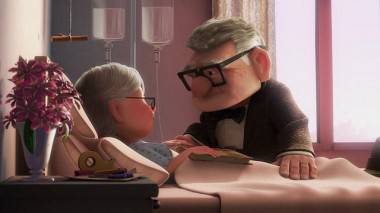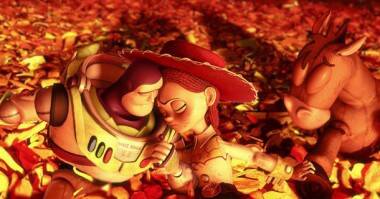Sad Moments in Feature Animation
The influence cartoons and animation has on children can be astonishing. People may ask ‘Where were you when Diana died’ or ‘Where were you when they landed on the moon’ but for many geeks significant moments also come in the form of animation. Quite a lot of people will remember when they saw Bambi’s mother die and it can bring audible whines and whimpers to even mention the Land Before Time.
Unfortunately a lot of memorable moments are sad moments in films and cartoons. This might be because of the bodies’ reaction. Watching animation as a child is normally something you do to be entertained so when you are young, being confronted with new and difficult themes such as death and loss can make an impact on you.These moments on screen will stay with you for a lifetime and may have driven you to want to create such beautiful images.
Here at Skwigly we wanted to look at some of these important on screen moments. We will look at how they animated, what happens in the scene, the use of color and how much we blubbed our eyes out.The following are not all the scenes that upset out childhoods but a few of the scenes that lots of animators told us ‘Stuck with them’.
Get the tissues handy.
The Lion King
The Lion King was a surprise hit for Disney. It was in and out of production for some time but finally hit our cinema screens in 1994.
The memorable scene in the film is the shocking demise of Mufasa. A young cub watches as his father falls to his death. This is awful enough but combine this with a psychotic uncle who blames his nephew for the death and being forced to run away after witnessing the death and you are smack bang in the middle of emotional turmoil.
This shocking scene comes after a brilliantly action packed stamped which included hundreds of CG buffalo. The calmness that follows, including the dust settling over the shot, the quiet music and the muted colors is a great jux-ta-position. The colorful grasslands is transformed to beiges and browns as Simba tries (and fails) to wake his father.
The actions animated by Simba mirror him waking his father from an earlier scene. This helps to reiterate how real the shock is for this small character that has been shown to be so weak in earlier shots, such as not being able to even scare a lizard.
The directors Roger Allers and Rob Minkoff, felt it was an important lesson for the audience to deal with. The Lion King shocked audience by killing off a main character within the first half of the film but this scene probably stays with audiences due to its use of music and color to pull on our heart strings.
Watership Down
Talking about Watership down to a group of people can produce frightening results. Not only do people seem to be upset by scenes in this movie but they seem genuinely frightened.
Watership down was originally a book by Richard Adams. The story centers on a group of rabbits. The small community has their own way of life and their own way of doing things. Their little world is shaken when they must move from their Warren to a new home.
In 1978 it was turned into an animated feature and directed by John Hubley who unfortunately died before production was finished in 1977. The new director was the films producer Martin Rosen.
The detailed naturalistic style of animation may be the cause for peoples upset as children since the film graphically depicts blood and scratches as well as a very long death scene for the character ‘Big Wig’ who gets chocked by a snare trap. This is rare for an animated children’s film and was ahead of its time.
The backgrounds in the film are created with watercolours. They are more of emotive features than detailed images which allowed the director to create an emotional feel to a scene through colour alone.
The film was given a ‘U’ certification when it was released and it has been defending its decision ever since.
“The BBFC rated the film ‘U’ (suitable for all), deciding that “…Whilst the film may move children emotionally during the films duration, it could not seriously trouble them once the spell of the story is broken and a ‘U’ certificate was therefore quite appropriate”. However in 2012, the BBFC admitted that it “has received complaints about the suitability of Watership Down at U almost every year since its classification”
There doesn’t seem to be a scene that people agree is the scariest death scene in this movie and that might be because of the sheer amount of deaths in the production. Threats of violence are ten a penny.
The scene in which the farmer’s dog attacks and graphically rips apart the rabbits is not only note worthy but terrifying.
The animator shows the rabbits to be mere chew toys that can be thrown around with ease. The gashes and wounds are also particularly terrifying. Even by today’s standards.
It would be interesting to see what rating this film would get today.
The music in the film, created by Mike Batt, is full of strings and wind instruments that add the drama. They alert the viewer of danger and do a good job as adding a touch of terror to any death scene. Over all this film takes animated deaths to a whole new level.
Bambi
There can’t really be a list about sad movie moments without including Bambi. This film, directed by James Algar, Samuel Armstrong,David Hand was the first of its kind. Its audience had only seen Snow White, Dumbo and Pinocchio previous to this and animation was still seen as a child’s form of entertainment so to have a character, especially a mother killed in a children’s film was shocking.
The scene isn’t shown in the film but implied. A shot is fired the music changes and Bambi is alone.
Many people we have spoke to say they were equally as scared of Bambi’s father as the hunter. Disney did a powerful job conveying the distance between father and son. This distance makes him telling Bambi he’s alone all the more shocking as it lacks empathy, let alone sympathy.
The scene begins with Bambi’s mother showing him the first signs of spring. This is the first sign that they have survived the cold harsh winter.
What we assume is the hunter’s point of view is shown to emphasis how vulnerable these two small creatures are. A white background of snow allows them to be the central focus.
The music builds to a crescendo as Bambi’s mother screams the line ‘don’t look back ‘. Bambi runs unto the dark undergrowth, calling to celebrate with his mother that they have escaped.
All ideas that spring has returned are gone as a snow starts to fall. The shadow and upward angles on Bambi’s father add to the imposing news,
Transformers: the movie.
A surprise addition to the list is the loss of Transforming lorry and all around robot hero, Optimus Prime. A lot of animators we spoke to felt the Optimuses demise in the film Transformers : The movie was the saddest moment on film. Transformers fans from the 80’s grew up on these multitasking robots so it’s no surprise that the death of their hero resonates with them.
The film came out in 1986 after being a successful television show and had the same director (Nelson Shin) and cast as the original show. The movie is set in 2005 and syncs up 20 years after the second season of the television show.
The movies aim was to deal with darker themes than the television show as well as to bring more of an anime style to the characters. The movie also set up season 3 of the television show.
The scene itself is of course during a battle between the Decepticons and the Autobots. The upbeat 80’s synth that is playing during the start of Optimuses death scene doesn’t give Optimus fate away and leads its fans into a false sense of security.
Megatron and Optimus battle as they have so many times before. Optimus wins the battle but allows Megatron to monologue him into a trap. Megatron places some killer blows and Optimus uses his last bit of strength to knock Megatron to his doom. The Decepticons retreat and everyone is happy but at the last second we realize Optimus is in trouble.
A death scene around a hospital bed changes the mood. The synth music becomes softer and quieter and the colors of the scene become more muted. Optimus gives the advice to his team ‘Do not grieve…’ and there is a teary 3 minute death scene that sees Optimus pass his leadership on.
In a television show where characters fight every week it was shocking for kids to see the life support machines flat line and for kids to lose their hero. This isn’t meant to happen? If that wasn’t sad enough the final blow comes when Optimus is drained of colour and turns black. There could only have been very teary eyed children (and quite a few adults) watching this scene.
Up
There isn’t too much to say about the first nine minutes of Up that you won’t already have thought about. It was a shockingly emotional and caring scene that was quite unexpected from a film whose synopsis consisted of: An old man and a young boy journey to South America in a floating house.
In 9 minutes without dialogue we watch as two young children find each other, fall in love, fix each other and grow old together only to lose each other.
The pink hues in this start sequence are reminiscent of a sunset. Pete Doctor (Director of Up) talks about how the pink represents Ellie and after she dies the pink fades. We start to see it disappear from shot as Karl walks home alone for the first time until he closes the door and the last pink light disappears leaving us with a grey and neutral world in which Karl now lives.
The music provided by Michael Giacchino perfectly captures the love and loss of the situation. It is hard to listen to the song ‘married life’ from the UP soundtrack without getting slightly emotional.
Different to most animated losses Karl and Ellie’s is real. It’s an inevitable passage that we see start and end which might be why it affects so many people. Many people may see a part of themselves in those first nine minutes because all we see is life passing by. No battle, no fight just life and its sad end.
The film is very smart with its use of Ellie. The first minutes of the film show her as an important character but instead of letting her fade Pixar use a lot of references to her through the film to tap back into the emotion felt at the start.
Ellie’s badge (The grape soda badge she gives Karl at the start) is a recurring item in the movie and used to make it feel Ellie is always with Karl. Karl’s references to the house as Ellie is also a great way to make Ellie feel like a important character through the whole film instead of just a start to a story.
The animation in this scene is sublime. The tiny gestures throughout the montage add a sense of caring that is hard to achieve without words or spoon feeding an audience. The way Ellie is animated to adjust Karl’s tie throughout their life is a caring but necessary gesture right up until the hospital scene when a weak tweak of his bow tie is done purely out of love and affection. She has done it for over 40 years and its second nature to her.
Another beautifully animated element to the scene is the humor. Ellie can be seen not just laughing but belly chuckling in the car before they get a flat tyre, which any animator will know is surprisingly hard to do effortlessly. The cheeky fun grin the Karl gives Ellie when his leg is broken also adds a sense of humor to this man. These elements make you like this character even though he will spend a great portion of the time grumpy and trying his best to be disliked.
All of this beautiful animation adds to the wonderful story telling and creates a relationship in a movie that tugs at your heart strings.
Toy Story 3
Toy Story 3 was hailed as the last installment of the Toy Story trilogy. When we, as an audience were aware this was the end of the franchise we were prepared to lose the characters, so when we are faced with the group in the furnace it isn’t farfetched to see it as an end.
It might be the most poignant moment of all three films. A children’s film full of plans and action suddenly smashed into reality. Up until the point that buzz holds out his hand for Jessie in the furnace you’ve never questioned a plan isn’t going to save them. Its Toy Story after all. These characters don’t discuss how to get out of situations, they just do it. Buzz opens a door so effortlessly you forget the physical feats he’s demonstrating.
So to see Jesse’s desperation when she asks Buzz ‘What are we going to do’ to only be responded with a long stare and a look that shows he has nothing left but his hand is heart wrenching. The animator has communicated the line ‘We die’ with a supportive smile and a simple gesture. In that long pause Jesse understands, accepts and instantly turns to comfort another friend like every other stage of their lives dying will just be something they do together.
You may be welling up just thinking about it. To present death in such a way in a children’s film is why Pixar has earned its followers. They know when to fold and they know when to show their cards. If the story requires the characters to deal with death they will. I’m sure there were many talks with many boards about this topic before the film came to cinemas but luckily what was good for the story won, even if it was scary and dark.
All of these films (and many more) demonstrate great story but most importantly, incredible skill. The animators, modelers and editors that work on these shots think of every element possible to put its audience into the right frame of mind.
It might be the biggest achievement of an animators career to invoke these kind of emotions. Through on some simple pencil lines, verts and clay you can create emotions.
Although they are sad moments let’s just hope that animators out there have a lot more to come.


